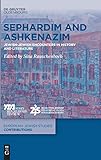Sephardim and Ashkenazim : Jewish-Jewish Encounters in History and Literature / ed. by Sina Rauschenbach.
Material type: TextSeries: Europäisch-jüdische Studien – Beiträge : Herausgegeben vom Moses Mendelssohn Zentrum in Kooperation mit dem Selma Stern Zentrum für Jüdische Studien Berlin-Brandenburg ; 18Publisher: München ; Wien : De Gruyter Oldenbourg, [2020]Copyright date: ©2021Description: 1 online resource (VI, 269 p.)Content type:
TextSeries: Europäisch-jüdische Studien – Beiträge : Herausgegeben vom Moses Mendelssohn Zentrum in Kooperation mit dem Selma Stern Zentrum für Jüdische Studien Berlin-Brandenburg ; 18Publisher: München ; Wien : De Gruyter Oldenbourg, [2020]Copyright date: ©2021Description: 1 online resource (VI, 269 p.)Content type: - 9783110695304
- 9783110695526
- 9783110695410
- online - DeGruyter
- Issued also in print.
| Item type | Current library | Call number | URL | Status | Notes | Barcode | |
|---|---|---|---|---|---|---|---|
 eBook
eBook
|
Biblioteca "Angelicum" Pont. Univ. S.Tommaso d'Aquino Nuvola online | online - DeGruyter (Browse shelf(Opens below)) | Online access | Not for loan (Accesso limitato) | Accesso per gli utenti autorizzati / Access for authorized users | (dgr)9783110695410 |
Frontmatter -- Table of Contents -- 1 Sephardim and Ashkenazim -- 2 Ashkenazim and Sephardim before (and after) the Modern Age -- 3 Creating a Visual Repertoire for the Late Medieval Haggadah -- 4 Early Modern Messianism between Ashkenazim and Sephardim -- 5 “All of the Differing Opinions of the Poskim, No One Fails to Appear” -- 6 Confluent and Conflictual Traditions in the Lagoon -- 7 Joining the Fight for Freedom -- 8 Kabbalah and Cosmopolitanism in Early Modern Amsterdam -- 9 Vienna -- 10 Max Nordau’s View on Sephardic Judaism and the Emergence of Political Zionism -- Selected Bibliography -- About the Authors -- Index of Names
restricted access online access with authorization star
http://purl.org/coar/access_right/c_16ec
Sephardic and Ashkenazic Judaism have long been studied separately. Yet, scholars are becoming ever more aware of the need to merge them into a single field of Jewish Studies. This volume opens new perspectives and bridges traditional gaps. The authors are not simply contributing to their respective fields of Sephardic or Ashkenazic Studies. Rather, they all include both Sephardic and Ashkenazic perspectives as they reflect on different aspects of encounters and reconsider traditional narratives. Subjects range from medieval and early modern Sephardic and Ashkenazic constructions of identities, influences, and entanglements in the fields of religious art, halakhah, kabbalah, messianism, and charity to modern Ashkenazic Sephardism and Sephardic admiration for Ashkenazic culture. For reasons of coherency, the contributions all focus on European contexts between the fourteenth and the nineteenth centuries.
Issued also in print.
Mode of access: Internet via World Wide Web.
In English.
Description based on online resource; title from PDF title page (publisher's Web site, viewed 28. Feb 2023)


